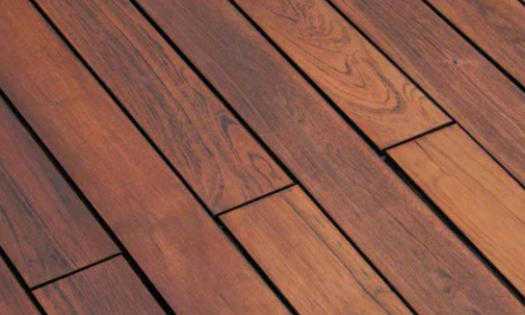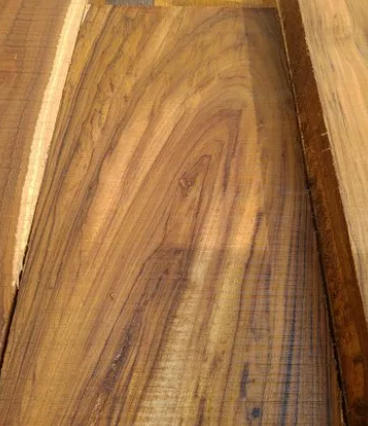










Content Menu
● Teak as a Hardwood – Scientific Classification
● Physical and Mechanical Properties of Teak
● Why Teak Is a Premium Hardwood
>> 2. Resistance to Moisture and Weather
>> 4. Longevity
● Comparing Teak with Other Popular Woods
>> 4. Interior Architecture and Paneling
>> 5. Fine Furniture and Carvings
● Sustainability and Environmental Impact
>> How the Industry Is Evolving
● How to Identify Genuine Teak
● Maintenance and Preservation
● Teak in Modern Architecture and Design
>> Modern Uses
● FAQ
>> 1. Is teak harder than oak?
>> 2. How long can teak furniture last?
>> 3. Does teak require sealing or varnish?
>> 4. Is plantation teak as good as Burmese teak?
>> 5. Why does teak turn gray over time?
Teak wood has long been considered among the world's most valuable and sought-after timbers. From luxury yachts and heritage furniture to traditional temples and modern architecture, teak's strength, natural oils, and exquisite color make it a timeless favorite. But one question often arises: Is teak truly a hardwood?
This comprehensive guide explores teak's classification, properties, benefits, and uses. We'll examine what makes it unique among hardwoods, its global applications, sustainability practices, and how to identify genuine teak in a crowded market.

Teak comes from the Tectona grandis tree, a tropical hardwood species native to South and Southeast Asia. It is widely cultivated across nations like India, Myanmar (Burma), Indonesia, and Thailand, and more recently in Central America and West Africa.
Teak trees thrive in regions with a monsoon climate—lush rainy seasons followed by drier months—promoting steady growth and dense grain development. A mature teak tree typically reaches 30–40 meters in height with a trunk diameter exceeding 1 meter, yielding large quantities of usable timber.
- Scientific Name: *Tectona grandis*
- Family: Lamiaceae (mint family)
- Tree Type: Deciduous hardwood
- Native Habitat: Tropical monsoonal regions of South and Southeast Asia
- Commercial Names: Burmese teak, Indonesian teak, African teak (though the latter is usually iroko, not true teak)
Although it belongs to the mint family, teak stands apart for its striking combination of density and resilience. This balance between hardness and workability makes it one of the most suitable woods for demanding construction and marine settings.
In forestry and woodworking, trees are divided into hardwoods and softwoods, but these terms can be misleading. The classification is based on botanical structure rather than literal hardness.
- Hardwoods come from angiosperms, or trees that produce flowers and enclosed seeds.
- Softwoods come from gymnosperms, which bear naked seeds in cones.
Since *Tectona grandis* is a deciduous flowering tree, teak is botanically classified as a hardwood. Beyond the classification, teak also exhibits the physical density and structural characteristics associated with true hardwoods—such as high compression strength and resistance to wear.
Teak's impressive combination of mechanical strength, weather resistance, and stability places it among the top-performing hardwoods for outdoor use.
| Property | Description |
|---|---|
| Density (air-dried) | 660–720 kg/m³ |
| Janka Hardness | ~1,070 lbf (4,740 N) |
| Modulus of Rupture (MOR) | 97 MPa |
| Modulus of Elasticity (MOE) | 12,000 MPa |
| Shrinkage (tangential) | 2.6% |
| Shrinkage (radial) | 1.4% |
Its relatively moderate hardness combined with strong elasticity gives teak the ideal balance for situations where both strength and flexibility are crucial, such as boat decks and outdoor furniture frameworks.
Teak's high oil content and silica presence make it naturally resistant to water, insects, and rot. These intrinsic oils act as internal preservatives, enabling teak structures to endure extreme climates for decades without chemical treatment.
Teak's reputation as a luxury hardwood is not just due to scarcity but because of its unparalleled real-world performance. Let's explore what sets teak apart from other woods.
The oils and resins in teak act as a natural barrier against fungi, termites, and marine borers. This makes it ideal for conditions where lesser woods would rot, crack, or warp.
Teak maintains its structural integrity in humid environments and resists saltwater corrosion. That's why it's the go-to choice for marine applications, such as flooring on yachts and cruise ships.
Low shrinkage rates mean teak doesn't distort much when temperatures and humidity fluctuate. It's particularly valued in climates with high seasonal variation.
Properly seasoned teak is known to last for 75–100 years, often outliving synthetic alternatives. Historical shipwreck recoveries have found teak perfectly intact after a century under the sea.
The wood's natural golden-brown tone with fine grain patterns complements both rustic and modern design themes. Over time, a silver-gray patina forms, symbolizing authenticity and age.
| Feature | Teak | Oak | Mahogany | Pine |
|---|---|---|---|---|
| Classification | Hardwood | Hardwood | Hardwood | Softwood |
| Janka Hardness (lbf) | 1,070 | 1,350 | 900 | 380 |
| Water Resistance | Excellent | Moderate | Moderate | Poor |
| Maintenance | Low | Medium | High | Very high |
| Durability Outdoors | Superior | Limited | Moderate | Unsuitable |
| Workability | Good | Good | Excellent | Easy |
| Natural Oil Content | High | Low | Moderate | Low |
This table highlights how teak stands in the middle range of hardness yet excels in weather resistance, dimensional stability, and minimal upkeep.

Teak's versatility extends from small decorative objects to robust structural features.
Due to its saltwater resistance, teak has been used in shipbuilding for centuries. From Viking ships to modern luxury yachts, its use ensures grip underfoot, rot prevention, and aesthetic appeal.
Teak's endurance in rain, sun, and snow makes it the ultimate material for outdoor benches, dining sets, loungers, and deck chairs. Unlike softer woods, it requires minimal finishing.
Teak flooring offers a warm hue, subtle texture, and non-slip surface. It's chosen for balconies, patios, and pool decks, where moisture exposure is inevitable.
High-end interiors use teak for flooring, ceilings, and wall trims, blending tropical elegance with modern minimalism. The fine, uniform grain allows smooth finishing.
Teak's uniform texture allows precise carving and joinery. Antique teak furniture from South Asia often remains intact even after hundreds of years, reflecting enduring craftsmanship.
Historically, teak came from old-growth forests in Myanmar, but deforestation concerns have spurred large-scale plantation cultivation.
- Grown for over a century in natural forest ecosystems
- Dense growth rings and darker color tones
- Higher silica and oil content
- Scarcer and tightly regulated by international trade laws
- Cultivated in regions like Indonesia, Costa Rica, and Ghana
- Managed under sustainable forestry systems with 20–40 year cycles
- More consistent size, lighter color
- Certified by international bodies like FSC (Forest Stewardship Council)
While old-growth teak is denser, modern plantations have narrowed the gap significantly through optimized genetics and controlled conditions.
As demand for teak has grown, sustainability has become critical. Deforestation in natural reserves led to trade restrictions on Burmese teak under the CITES (Convention on International Trade in Endangered Species) framework.
- Reforestation Programs: Many countries are restoring degraded lands with teak plantations.
- Eco-certifications: Brands and furniture manufacturers increasingly rely on FSC-certified sources.
- Reclaimed Teak: Salvaging wood from old buildings or ships helps reduce pressure on forests while offering vintage charm.
Buying sustainably certified teak ensures not just quality but also ethical and environmental responsibility.
Market shelves are filled with imitation teak products made from acacia, mahogany, or composite veneer. Here's how to recognize real teak wood:
1. Color: Genuine teak is honey-gold to dark brown, turning gray with time.
2. Grain: Straight to wavy with occasional darker streaks.
3. Texture: Slightly oily or waxy to the touch.
4. Weight: Significantly denser than softwoods or synthetic alternatives.
5. Smell: Emits a mild leathery, oily scent when freshly cut due to natural oils.
Fake teak often lacks the oily texture and subtle fragrance that authentic teak naturally possesses.
Though teak is nearly maintenance-free, following some care tips will ensure its brilliance lasts decades.
- Routine Cleaning: Use soft brushes with mild soap and water. Avoid abrasive cleaners.
- Oiling (Optional): Re-oil annually if preserving the golden color. Un-oiled teak will gracefully silver with weather exposure.
- Avoid Varnish: Varnish prevents natural oil migration, causing cracking over time.
- Protection: During off-season, use breathable covers rather than airtight plastic.
- Regular Inspection: Check joints and fasteners on furniture for corrosion or looseness.
Teak has adapted seamlessly into modern lifestyle trends emphasizing sustainability and natural materials. Its rich tones and durability resonate with homeowners, designers, and architects seeking timeless value.
- Eco-luxury Interiors: Blends beautifully with stone, glass, and metal.
- Wellness and Spa Facilities: Preferred for its moisture resistance and organic look.
- Outdoor Resorts and Villas: Used for decking, pergolas, and poolside furniture.
- Yacht Decking: Maintains grip even when wet, combining function and prestige.
Whether in coastal resorts or minimalist homes, teak's enduring appeal lies in its fusion of beauty, strength, and sustainability.
So, is teak a hardwood? Without question — both in botanical classification and in practical performance. Teak wood embodies everything a premium hardwood should provide: durability, elegance, resistance, and adaptability.
Its legendary ability to endure tropical rains, salty seas, and time itself makes it a material trusted for generations. Whether sourced from sustainably managed plantations or reclaimed heritage structures, teak remains a symbol of excellence and preservation.
In a world increasingly mindful of sustainability, responsibly harvested teak offers an ideal intersection of luxury, longevity, and environmental balance. When you choose teak, you're not merely buying wood — you're investing in a piece of living history that will last for decades to come.

Teak's Janka hardness is around 1,070 lbf, slightly lower than oak's 1,350 lbf. However, its oil content provides superior outdoor durability, giving it practical performance advantages beyond simple hardness.
Outdoor teak furniture can last over 70 years, and indoor items can easily exceed a century with minimal maintenance, making it one of the most durable woods known.
No. Natural oils make teak naturally water-resistant. Adding varnish may trap moisture and accelerate damage, so gentle cleaning and optional oiling are recommended instead.
Yes, high-grade FSC-certified plantation teak offers nearly the same durability and structural integrity as old-growth Burmese teak, with added sustainability benefits.
Exposure to sunlight oxidizes teak's surface oils, producing the signature silvery-gray patina. This doesn't affect its strength or lifespan—in fact, it's a sign of natural weathering and authenticity.